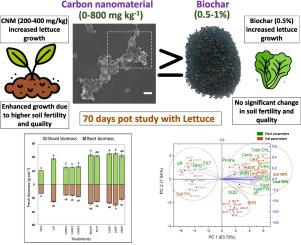NanoImpact ( IF 4.9 ) Pub Date : 2023-08-23 , DOI: 10.1016/j.impact.2023.100480 Jaya Nepal 1 , Xiaoping Xin 1 , Gabriel Maltais-Landry 2 , Wiqar Ahmad 3 , Jorge Pereira 4 , Swadeshmukul Santra 5 , Alan L Wright 1 , Andy Ogram 2 , Peter J Stofella 6 , Zhenli He 1

|
A significant bottleneck of current agricultural systems remains the very low agronomic efficiency of conventional agrochemicals, particularly in sandy soils. Carbon nanomaterials (CNMs) have been proposed to address this inefficiency in sandy soils, which could potentially improve soil fertility and enhance crop growth and physiological processes. However, the effects of different rates of CNMs on crop physiological and soil biochemical quality in sandy soils must be compared to other carbon sources (e.g., biochar) before CNMs can be broadly used. To address this, a 70-day pot experiment was set up, growing lettuce under ten treatments: a negative control with no CNMs, biochar or fertilizer; a fertilizer-only control; three CNMs-only unfertilized treatments (CNMs at 200, 400 and 800 mg kg−1 soil); two biochar treatments with fertilizer (biochar at 0.5% and 1% by soil mass + fertilizer); and three CNMs treatments with fertilizer (CNMs at 200, 400 and 800 mg kg−1 soil + fertilizer). A novel amorphous, water-dispersible, and carboxyl-functionalized CNMs with pH of 5.5, zeta potential of −40.6 mV and primary particle diameter of 30–60 nm was used for this experiment. Compared to the fertilizer-only control, CNMs applied at low to medium levels (200–400 mg kg−1) significantly increased lettuce shoot biomass (20–21%), total chlorophyll (23–27%), and fluorescence and photosynthetic activities (4–10%), which was associated with greater soil nutrient availability (N: 24–58%, K: 68–111%) and higher leaf tissue accumulation (N: 25–27%; K: 66%). Low to medium levels of CNMs also significantly increased soil biochemical properties, such as higher soil microbial biomass carbon (27–29%) and urease enzyme activity (34–44%) relative to fertilizer-only applications. In contrast, biochar (0.5%) increased lettuce biomass relative to fertilizer-only but had no significant effect on soil fertility and biological properties. These results suggest that CNMs at low to medium application rates are a superior carbon-based amendment relative to biochar in sandy soils.
中文翻译:

基于对生菜生长、生理和土壤生化质量的影响,碳纳米材料是比生物炭更好的沙质土壤改良剂
当前农业系统的一个重要瓶颈仍然是传统农用化学品的农艺效率非常低,特别是在沙土中。碳纳米材料(CNM)已被提议用来解决沙质土壤中的这种低效率问题,这可能会提高土壤肥力并促进作物生长和生理过程。然而,在CNMs广泛使用之前,必须将不同用量的CNMs对沙土中作物生理和土壤生化质量的影响与其他碳源(例如生物炭)进行比较。为了解决这个问题,我们进行了为期 70 天的盆栽实验,在十种处理下种植生菜:阴性对照,不使用 CNM、生物炭或肥料;仅施肥控制;三种仅使用 CNM 的未施肥处理(CNM 为 200、400 和 800 mg kg -1土壤);两次生物炭加肥料处理(生物炭分别占土壤质量的 0.5% 和 1% + 肥料);以及三种加肥料的 CNM 处理(CNM 为 200、400 和 800 mg kg -1土壤 + 肥料)。本实验使用了一种新型无定形、水分散性和羧基功能化的 CNM,pH 为 5.5,zeta 电位为 -40.6 mV,初级粒径为 30-60 nm。与仅施肥对照相比,低至中等水平(200–400 mg kg -1)施用 CNM 显着增加了生菜地上部生物量(20–21%)、总叶绿素(23–27%)以及荧光和光合活性(4–10%),这与较高的土壤养分利用率(N:24–58%,K:68–111%)和较高的叶组织积累(N:25–27%;K:66%)相关。低至中等浓度的 CNM 还显着提高了土壤生化特性,例如相对于仅施用肥料而言,土壤微生物生物量碳(27-29%)和脲酶活性(34-44%)更高。相比之下,相对于仅施用肥料,生物炭(0.5%)增加了生菜生物量,但对土壤肥力和生物特性没有显着影响。这些结果表明,在沙质土壤中,低至中等施用量的 CNM 是一种优于生物炭的碳基改良剂。



























 京公网安备 11010802027423号
京公网安备 11010802027423号